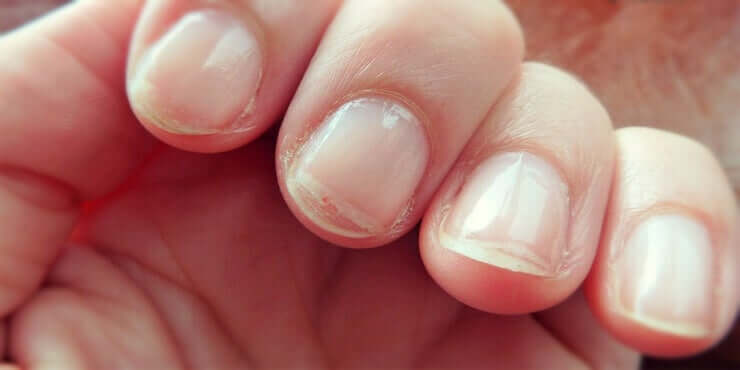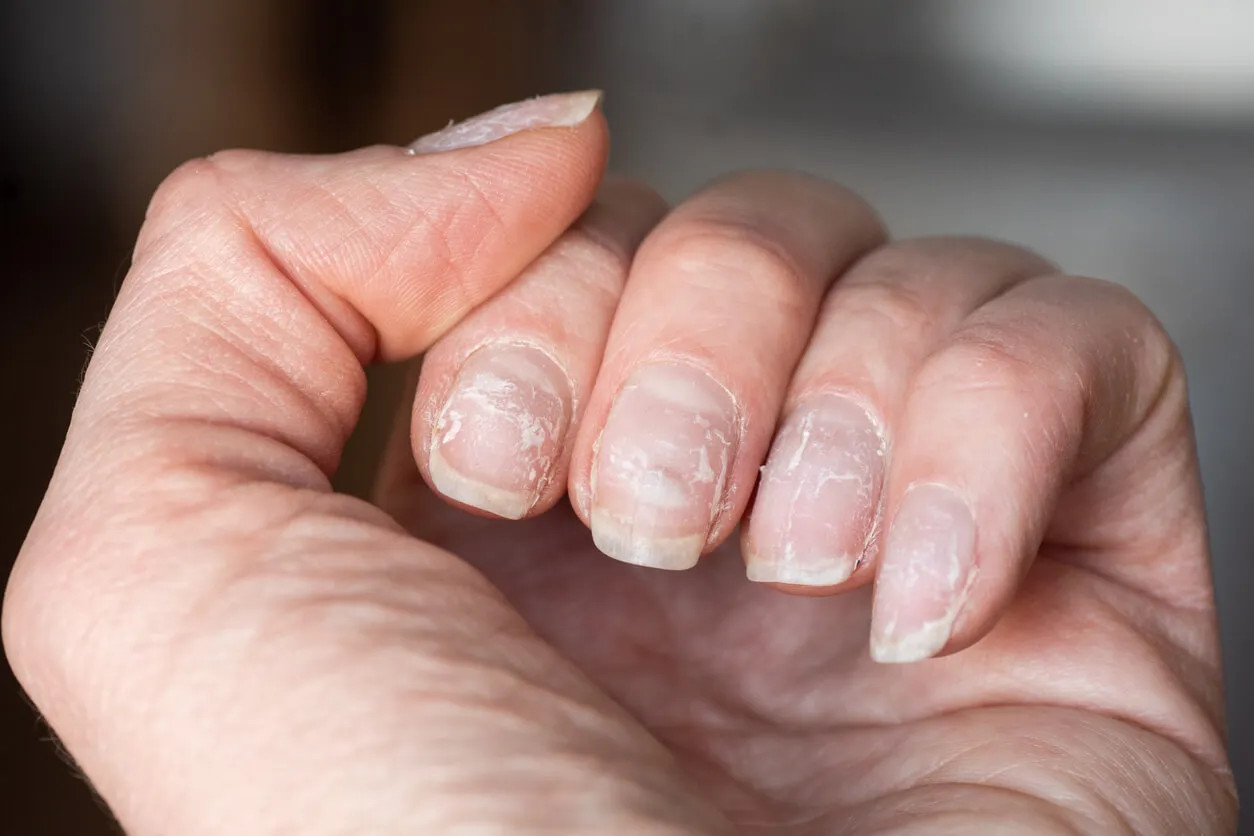Wavy Nails: Why it Happens and How to Fix Them


Reviewed and approved by the nurse Leidy Mora Molina
Wavy nails can be a sign of a health problem. However, they can also be a sign of neglect, and you just need to take care of them properly. Most problems are treatable and fixable.
Most often, wavy nails are just another effect of aging. However, if this condition raises concerns or doubts, it’s best to consult a doctor for a more accurate assessment.
Wavy nails

It’s very easy to detect wavy nails: just look at them carefully and check for canals. It’s also important to look for changes in color, thickening, or other bumps on the surface.
Nail waves can be of two types: vertical or horizontal. The most common are the vertical ones, which are almost always the result of age. They don’t usually pose any risk, except that they sometimes weaken the area and lead to brittle nails.
Horizontal lines on the nails are less common and in some cases are a sign of a health problem. It’s possible that it’s an effect of nail psoriasis, but also of other diseases. Anyway, in this case, as in the previous one, more than the shape of the wave, what is important is the severity and the other symptoms.
The causes of wavy nails
As we’ve already suggested, the causes of wavy nails can be many. Some of them aren’t serious and require only a few care measures. Others have to do with more serious health problems. Let’s take a look.
Blows
Blows on the nails often go unnoticed, but they leave traces. Most commonly, the nails are crushed when closing a book or a door. The effect of this is a bruise and sometimes wavy nails. It usually goes away on its own, but can also lead to nail dystrophy, which requires medical treatment.
Aggressive manicures
Some manicure procedures can affect the structure of the nail. In particular, false implants do this. It’s not uncommon for them to cause an indentation and create a wave. Likewise, using low-quality products or removing polish by hand often leads to the appearance of these horizontal or vertical grooves.
A keratin deficiency
Keratin is a protein found in the superficial part of the skin, hair, and nails. Pollution, some external agents, inadequate nutrition, or even stress can lead to a deficit in this and other proteins. If this happens, the nails weaken and, in many cases, grooves appear on their surface.
Aging
This is the most common cause of wavy nails. It is a natural process of wear and tear that has no health implications. However, if the lines are not simple grooves, but show some coloration, or if the surface changes tone or thickens, it’s important to see a doctor.
Like this article? You may also like reading: 9 Home Treatments to Strengthen Weak Nails
A nutritional deficiency
Deficiency of vitamins A and B, as well as calcium or zinc, cause wavy nails. The appearance is rough and white dots or spots are commonly seen. In addition, the cuticles are thickened, and the nail becomes brittle. In these cases, a doctor should be consulted.
Fungal infections
Fungal infections are most common on toenails, but can also appear on fingernails. These diseases alter the shape, color, and volume of the nail. The appearance is thicker and harder, with a yellowish tone. It’s also common for waves or roughness to appear.
Nail psoriasis
It’s estimated that 80-90% of people with psoriasis also have nail psoriasis. This results in wavy nails, as well as changes in shape, size, and volume. Also, it’s common for holes to form, and there’s often discoloration that later turns yellowish or brownish.
You may also like to read this article: 11 Natural Remedies to Get Rid of Nail Fungus
Wavy nails could be a sign of trachyonychia
Trachyonychia is a condition characterized by rough nails. The nails look as if they have been damaged with sandpaper and are often wavy. It can be an isolated problem or be part of a more complex picture that includes psoriasis, lichen planus, or alopecia areata.
Digestive problems
Although it may seem strange at first, digestive problems also cause wavy nails. These conditions interfere with the absorption of nutrients and change the appearance of that area. Crohn’s disease, ulcerative colitis, and celiac disease are among the conditions that cause this consequence.
Anemia can lead to wavy nails
Anemia involves a deficiency of red blood cells; one of its consequences can be wavy nails. The surface of the nails looks irregular, opaque, and with signs of weakness. In these cases, a doctor should be consulted for treatment.
Diabetes
Wavy nails can also be a sign of diabetes. This disease has the potential to alter the growth process of the nails, resulting in the appearance of vertical, sinuous-looking ridges. It’s important to note that other symptoms such as excessive thirst, increased urine production, and weight gain are also present.
Cancer
The characteristic symptom of nail cancer is the so-called “Hutchinson’s sign.” This is a black, gray, or brown coloration that extends around the nail. However, it’s not present in all cases. That said, what is present is changes in texture and appearance, including rippling, grooves, dimpling, etc. Also, there is usually a lifting of the nail plate.
Other conditions
Nail ripples can be the effect of other diseases such as rheumatoid arthritis, kidney pathologies, peripheral vascular disease, thyroid problems, mumps, and syphilis. Therefore, it’s always important to pay attention to the presence of waviness in your nails.
Solutions for wavy nails

The treatment of wavy nails will depend on the cause of the waviness. In case it’s the effect of a systemic or another disease, the treatment will consist of treating the underlying disease.
You can’t do much to reverse the process of aging. Usually, only measures are taken to disguise the undulations, with enamel or soft sanding. If the problem stems from an infection, antifungal pills, creams, or polishes will most likely be prescribed.
There are strengthening polishes that are very effective in combating wavy nails. It is also advisable to apply a hardener, either commercial or homemade. It is advisable to cut your nails regularly and not use metallic files.
Consult your doctor if you have wavy nails
The best thing to do is to give your nails a couple of weeks to rest from the application of cosmetic products on them. Nail implants are not advisable, as well as the use of removers containing acetone.
It’s important to wash your nails regularly and dry them very well since humidity is not helpful. In case there are noticeable changes, such as very visible wavy nails or changes in color or appearance, it’s advisable to visit the doctor.
All cited sources were thoroughly reviewed by our team to ensure their quality, reliability, currency, and validity. The bibliography of this article was considered reliable and of academic or scientific accuracy.
- Armesto, S., Esteve, A., Coto-Segura, P., Drake, M., Galache, C., Martínez-Borra, J., & Santos-Juanes, J. (2011). Psoriasis ungueal: estudio en 661 pacientes con psoriasis vulgar. Actas Dermo-Sifiliográficas, 102(5), 365-372.
- Dávila, M. E., Zorrilla, A., Memije, M. E. V., & Guzmán, R. A. (2019). Traquioniquia: una visión práctica. Dermatología Cosmética, Médica y Quirúrgica, 16(4), 306-309.
- Suárez, B. P. (2011). El lenguaje de las uñas. Más dermatología, (15), 4-12.
This text is provided for informational purposes only and does not replace consultation with a professional. If in doubt, consult your specialist.








